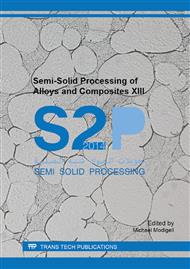p.188
p.195
p.201
p.208
p.219
p.227
p.235
p.241
p.247
Simulation on the Thixocasting Process of the Turbocharger Impellers and Selection of the Viscosity Models
Abstract:
The thixocasting technology is chosen to produce the turbocharger impellers as it is capable of producing castings with high precision dimension, free of oxide and shrinkage porosity defects and therefore long service life. The thixocasting turbocharger impellers have the similar mechanical property to those produced by forging and machine processes, but much less costs. In the thixocasting process, the semisolid slurry with certain solid fraction is injected into mould at a high speed. Since high viscosity and thixotropic characteristics, the semisolid slurry reveals unique flow condition and characteristics in the filling process. So, its very desirable for the die design, process optimization, and defect control to visualize the high-speed filling process of semisolid slurry by numerical simulation. In this paper, several commonly used viscosity models for semisolid slurry are analysed. The Power law cut-off model (PLCO) model is selected to simulate the filling process in the thixocasting process of the impellers of 319s alloy, compared with actual results by partial filling testing. The causes of the casting defects are also analysed, indicating that the simulation results can accurately reproduce the filling process of semisolid slurry, and PLCO model is a successful choice for simulating the filling process of semisolid slurry with high solid fraction.
Info:
Periodical:
Pages:
219-224
Citation:
Online since:
September 2014
Authors:
Keywords:
Price:
Сopyright:
© 2015 Trans Tech Publications Ltd. All Rights Reserved
Share:
Citation:


